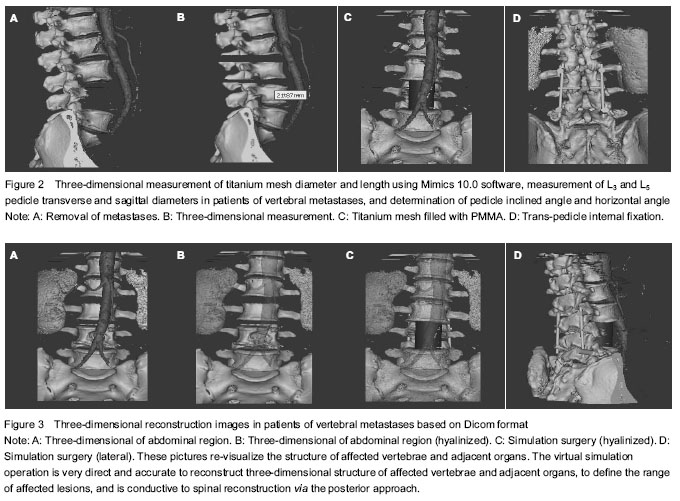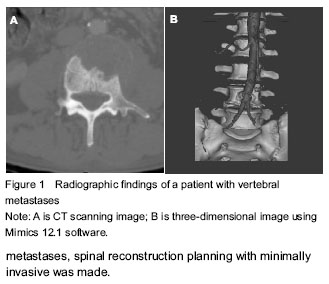| [1] Borani S, Weinstein JN, Biagini R. Primary bone tumor of thespine. Spine. 1997;22(9):1036-1044.
[2] Boriani S, Bandiera S, Biagini R, et al. Staging and treatment of primary tumors of the spine. Current Opinion in Orthopedics. 1999;10(2):93-100.
[3] Doh JW, Halliday AL, Baldwin NG, et al. Spinal stabilization by using crossed-SCrew anterior-posterior fixation after multisegmental total Spondylectomy for thoracic chondrosarcoma: case report. J Neurosury. 2001;94(Suppl): 279-283.
[4] Tomita K, Kawahara N, Kobayashi T, et al. Surgical strategy for spinal metastases. Spine. 2001;26:298-306.
[5] Abe E, Kobayashi T, Murai H, et al. Total spondylectomy for primary malignant, aggressive benign, and solitary metastatic bone tumor of the thoracolumbar spine. J Spine Disorder. 2001;14:237-246.
[6] Wang Q, Song Y, Zhuang H, et al. Robotic stereotactic irradiation and reirradiation for spinal metastases: safety and efficacy assessment. Chin Med J (Engl). 2014;127(2): 232-238.
[7] Bohinski RJ, Rhines L. Principles and techniques of enblocvertebrectomy for bone tumors of the thoracolumbar spine: an overview. Neurosurg Focus. 2003;15(5):1-6.
[8] Amiot LP, Lang K, Putzier M, et al. Comparative results between conventional and computer-assisted pedicle screw installation in the thoracic, lumbar and sacral spine. Spine. 2000;25:606-614.
[9] Dickman CA, Yahiro MA, Lu HTC, et al. Surgical treatment alternatives for fixation of unstable fractures of the thoracic and lumbar spine. Spine. 1994;19(Suppl):2266-2273.
[10] Ebraheim NA, Xu R, Ahmad M, et al. Projection of the thoracic pedicle and its morphometric analysis. Spine.1997; 22:233-238.
[11] Esses SI, Sachs BL, Dreyzin V. Complications associated with the technique of pedicle screw fixation. Spine. 1993;18: 2231-2239.
[12] Laine T, Lund T, Ylikoski M, et al. Accuracy of pedicle screw insertion with and without computer assistance. A randomised controlled clinical study in 100 consecutive patients. Eur Spine J. 2000;9:235-240.
[13] Rampersaud YR, Foley KT, Shen AC, et al. Radiation exposure to the spine surgeon during fluoroscopically assisted pedicle screw insertion. Spine. 2000;25:2537- 2645.
[14] Rampersaud YR, Simon DA, Foley KT. Accuracy requirements for image-guided spinal pedicle screw placement. Spine. 2001;26:352-359.
[15] Robertson PA, Stewart NR. The radiologic anatomy of the lumbar and lumbosacral pedicles. Spine. 2000;25: 709-715.
[16] Schlenzka D, Laine T, Lund T. Computer-assisted spine surgery. Eur Spine J. 2000;9(Suppl 1):57-64.
[17] Schulze CJ, Munzinger E, Weber U. Clinical relevance of accuracy of pedicle screw placement. A computer tomographic- supported analysis. Spine. 1998;23:2215- 2220.
[18] Yuan HA, Garfin SR, Dickman CA, et al. A historical cohort study of pedicle screw fixation in thoracic, lumbar, and sacral spinal fusions. Spine. 1994;(Suppl):2279-2296.
[19] Vahldiek MJ, Panjabi MM. Stability potential of spinal instrumentations in tumor vertebral body replacement surgery. Spine. 1998;23:543-550.
[20] Abe Y, Sato S, Kato K, et al. A novel 3D guidance system using augmented reality for percutaneous vertebroplasty: technical note. J Neurosurg Spine. 2013;19(4):492-501.
[21] Cabrilo I, Bijlenga P, Schaller K. Augmented reality in the surgery of cerebral arteriovenous malformations: technique assessment and considerations. Acta Neurochir (Wien). 2014;156(9):1769-1774.
[22] Shi J, Xia J, Wei Y, et al. Three-dimensional virtual reality simulation of periarticular tumors using Dextroscope reconstruction and simulated surgery: a preliminary 10-case study. Med Sci Monit. 2014;20:1043-1050.
[23] Hua H, Javidi B. A 3D integral imaging optical see-through head-mounted display. Opt Express. 2014;22(11):13484- 13491.
[24] Shi J, Xia J, Wei Y, et al. Three-dimensional virtual reality simulation of periarticular tumors using Dextroscope reconstruction and simulated surgery: a preliminary 10 case study. Acta Orthop Belg. 2014;80(1):132-138.
[25] Hänel C, Pieperhoff P, Hentschel B, et al. Interactive 3D visualization of structural changes in the brain of a person with corticobasal syndrome. Front Neuroinform. 2014;8:42.
[26] Soler L, Nicolau S, Pessaux P, et al. Real-time 3D image reconstruction guidance in liver resection surgery. Hepatobiliary Surg Nutr. 2014;3(2):73-81.
[27] Eve EJ, Koo S, Alshihri AA, et al. Performance of dental students versus prosthodontics residents on a 3D immersive haptic simulator. J Dent Educ. 2014;78(4): 630-637.
[28] Pessaux P, Diana M, Soler L, et al. Robotic duodenopancreatectomy assisted with augmented reality and real-time fluorescence guidance. Surg Endosc. 2014; 28(8):2493-2498.
[29] Di Somma A, de Notaris M, Stagno V, et al. Extended endoscopic endonasal approaches for cerebral aneurysms: anatomical, virtual reality and morphometric study. Biomed Res Int. 2014;2014:703792.
[30] Zhou Y, Bailey J, Ioannou I, et al. Constructive real time feedback for a temporal bone simulator. Med Image Comput Comput Assist Interv. 2013;16(Pt 3):315-322.
[31] Duarte IC, Ferreira C, Marques J, et al. Anterior/posterior competitive deactivation/activation dichotomy in the human hippocampus as revealed by a 3D navigation task. PLoS One. 2014;9(1):e86213.
[32] Uchida M. Recent advances in 3D computed tomography techniques for simulation and navigation in hepatobiliary pancreatic surgery. J Hepatobiliary Pancreat Sci. 2014; 21(4):239-245.
[33] Baken L, Rousian M, Koning AH, et al. First-trimester detection of surface abnormalities: A comparison of 2- and 3-dimensional ultrasound and 3-dimensional virtual reality ultrasound. Reprod Sci. 2014;21(8):993-999.
[34] Lin Q, Xu Z, Li B, Baucom R, et al. Immersive virtual reality for visualization of abdominal CT. Proc SPIE. 2013;8673.
[35] Hong K, Yeom J, Jang C, et al. Full-color lens-array holographic optical element for three-dimensional optical see-through augmented reality. Opt Lett. 2014;39(1): 127-130.
[36] Gong RH, Güler Ö, Kürklüoglu M, et al. Interactive initialization of 2D/3D rigid registration. Med Phys. 2013; 40(12):121911.
[37] Liu YG, Zuo LX, Pei GX, et al. Establishment of Schatzker classification digital models of tibial plateau fractures and its application on virtual surgery. Zhonghua Yi Xue Za Zhi. 2013; 93(31):2478-2482.
[38] Djukic T, Mandic V, Filipovic N. Virtual reality aided visualization of fluid flow simulations with application in medical education and diagnostics. Comput Biol Med. 2013; 43(12):2046-2052.
[39] Rassweiler J, Rassweiler MC, Müller M, et al. Surgical navigation in urology: european perspective. Curr Opin Urol. 2014;24(1):81-97.
[40] Qi S, Yan Y, Li R, et al. The impact of active versus passive use of 3D technology: a study of dental students at Wuhan University, China. J Dent Educ. 2013;77(11):1536-1542.
[41] Berry F, Aider OA, Mosnier J. A visual servoing-based method for ProCam systems calibration. Sensors (Basel). 2013;13(10):13318-13323.
[42] Jackson B, Lau TY, Schroeder D, et al. A lightweight tangible 3D interface for interactive visualization of thin fiber structures. IEEE Trans Vis Comput Graph. 2013;19(12): 2802-2809.
[43] Hsu WH, Zhang Y, Ma KL. A multi-criteria approach to camera motion design for volume data animation. IEEE Trans Vis Comput Graph. 2013;19(12):2792-2801.
[44] Zinser MJ, Mischkowski RA, Dreiseidler T, et al. Computer-assisted orthognathic surgery: waferless maxillary positioning, versatility, and accuracy of an image-guided visualisation display. Br J Oral Maxillofac Surg. 2013;51(8):827-833.
[45] Dores AR, Almeida I, Barbosa F, et al. Effects of emotional valence and three-dimensionality of visual stimuli on brain activation: an fMRI study. NeuroRehabilitation. 2013;33(4):505-512. |

